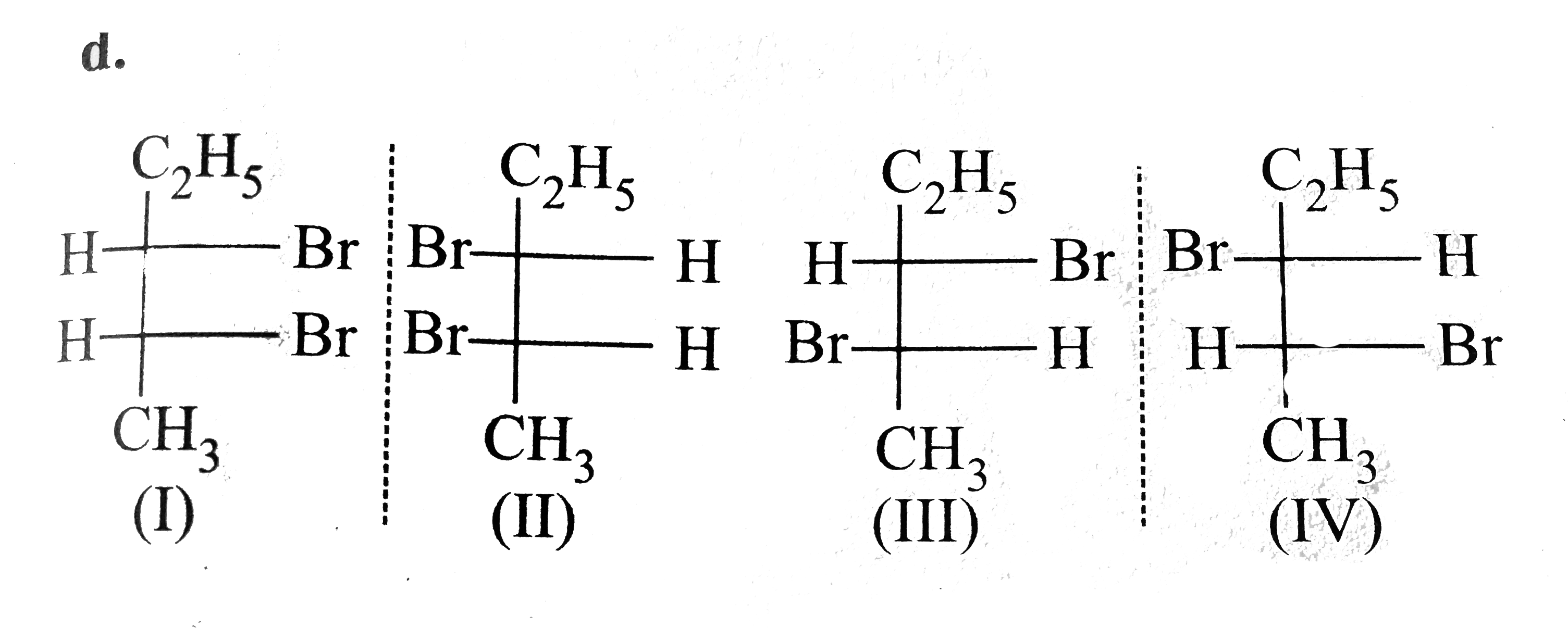A schematic analysis of the reaction of the enantiomer with racemic mixture is shows below:
d+d and l−−→(d)−(d)The(+)-form ofA racemic mixture of+chiral moleculesother molecules with(d)−(l)50%(d)and50%(l)
The products (d-d) and (d-l) are clearly neither identical nor enantiomers (non-superimposable mirror images) as the diastereomers, stereoisomers that are not mirror images' . The formation of diasteromers allows the separation of enantiomers (called resolution) which is not easy as enantiomers have identical physical properties. One general with naturally occurring chiral molecule to form a pair of diastereomers. These can be separated easily as they have different physical properties. If the original chemical reaction can be reversed, the enantiomers can be isolated.
How many diastereomers are possible among all the possible stereoisomers of 2,3-dibromopentane ?
A
(a) 2
B
(b) 1
C
(c) 3
D
(d) 4
Video Solution
Text Solution
The correct Answer is:D

(So in total four isomers exist.)
|
Updated on:21/07/2023
Topper's Solved these Questions
- BOOK - CENGAGE CHEMISTRYCHAPTER - ALKANES AND CYCLOALKANESEXERCISE - True and False1videos
ALKANES AND CYCLOALKANES
- BOOK - CENGAGE CHEMISTRYCHAPTER - ALKANES AND CYCLOALKANESEXERCISE - Fill in the Blanks1videos
ALKANES AND CYCLOALKANES
- BOOK - CENGAGE CHEMISTRYCHAPTER - ALKANES AND CYCLOALKANESEXERCISE - EXERCISES24videos
ALKANES AND CYCLOALKANES
- BOOK - CENGAGE CHEMISTRYCHAPTER - ALKENES AND ALKADIENESEXERCISE - Single correct Answer14videos
ALKENES AND ALKADIENES
Similar Questions
Knowledge Check
- Question 1 - Select One
A schematic analysis of the reaction of the enantiomer with racemic mixture is shows below:
d+d and l−−→(d)−(d)The(+)-form ofA racemic mixture of+chiral moleculesother molecules with(d)−(l)50%(d)and50%(l)
The products (d-d) and (d-l) are clearly neither identical nor enantiomers (non-superimposable mirror images) as the diastereomers, stereoisomers that are not mirror images' . The formation of diasteromers allows the separation of enantiomers (called resolution) which is not easy as enantiomers have identical physical properties. One general with naturally occurring chiral molecule to form a pair of diastereomers. These can be separated easily as they have different physical properties. If the original chemical reaction can be reversed, the enantiomers can be isolated.
Which of the following is not true ?A(a) Diastereomers have different melting points and solubilities in a given solvent.B(b) Diasteromers have similar chemical properties.C(c) Distereomers are optically active compounds with same or optisite sign of rotaion.D(d) Diastereomers differ in adsorption. - Question 2 - Select One
A schematic analysis of the reaction of the enantiomer with racemic mixture is shows below:
d+d and l−−→(d)−(d)The(+)-form ofA racemic mixture of+chiral moleculesother molecules with(d)−(l)50%(d)and50%(l)
The products (d-d) and (d-l) are clearly neither identical nor enantiomers (non-superimposable mirror images) as the diastereomers, stereoisomers that are not mirror images' . The formation of diasteromers allows the separation of enantiomers (called resolution) which is not easy as enantiomers have identical physical properties. One general with naturally occurring chiral molecule to form a pair of diastereomers. These can be separated easily as they have different physical properties. If the original chemical reaction can be reversed, the enantiomers can be isolated.
Which of the following is an example of diastereomers ?A(a) Two gauche forms of butane.B(b) Products of bromination of cis-2-butene in the presence of CCl4.C(c) Gauche and anti fortms of butane.D(d) Both (a) and (c). - Question 3 - Select One
An enantiomer and its racemic form have
Aequal and opposite rotationBunequal and oppoiste rotationsCequal and identical rotationsDnone of these
Separating of d and l enantiorphs from a racemic mixture is called
View SolutionSeparating of d and l enantiorphs from a racemic mixture is called
View SolutionThe process of separation of racemic modifications into d and l enantiomers is called:
View SolutionThe process of separation of racemic modifications into d and l enantiomers is called:
View SolutionThe process of separating of a racemic mixture into d and l enantiomers is called
View Solution

